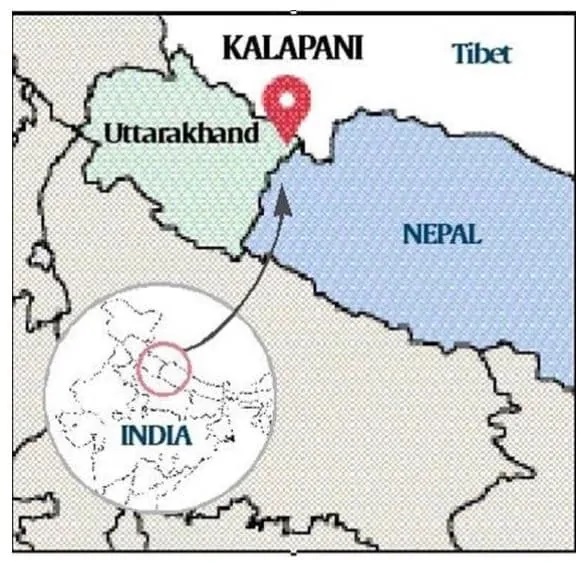Why in news?
Nepal will increase the number of security outposts and deploy more armed personnel in the border with India.
Kathmandu expects India to avoid any unilateral measures in the Kalapani region and remain committed to the ‘fixed border’ principle as agreed during the past official talks.
This comes after India completed the road connectivity from Dharchula to Lipulekh (China Border) famously known as Kailash-Mansarovar Yatra Route.
Kalapani Region

- The Kalapani region is claimed by Nepal but India has been maintaining that the new political map of 2019 has shown the territory “accurately” as part of Uttarakhand.
- This region is under Indian administration as part of Pithoragarh district in the Uttarakhand state.
- According to Nepal’s claim, it lies in Darchula district, Sudurpashchim Pradesh.
- It is marked by the Kalapani river, one of the headwaters of the Kali River in the Himalayas at an altitude of 3600–5200 meters.
- The valley of Kalapani, with the Lipulekh Pass at the top, forms the Indian route to Kailash–Manasarovar, an ancient pilgrimage site.
- It is also the traditional trading route to Tibet for the Bhotiyas of Uttarakhand.
- The Treaty of Sugauli signed by the Kingdom of Nepal and British India (after Anglo-Nepalese War) in 1816 located the Kali River as Nepal’s western boundary with India.
- The discrepancy in locating the source of the river led to boundary disputes between India and Nepal, with each country producing maps supporting their own claims.
- The Kali River forms the boundary between India and Nepal in this region. However, India states that the headwaters of the river are not included in the boundary.
Kali River (Sharda river or Kali Ganga in Uttarakhand)
- Kali River joins Ghagra river in Uttar Pradesh, which is a tributary of Ganga.
- Tanakpur hydro-electric project, Chameliya hydro-electric project, Sharda Barrage are the projects on the river.
Read More about the New Kailash-Mansarovar Yatra Route here: https://www.legacyias.com/pib-8th-may/
(1st Article of 8th May PIB Summary)
-Source: The Hindu




